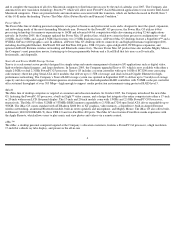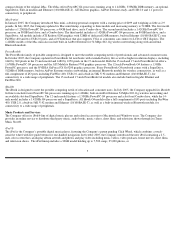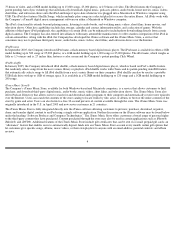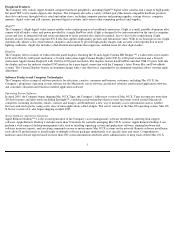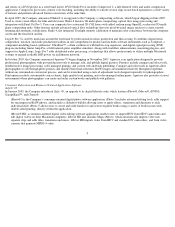Apple 2005 Annual Report Download - page 16
Download and view the complete annual report
Please find page 16 of the 2005 Apple annual report below. You can navigate through the pages in the report by either clicking on the pages listed below, or by using the keyword search tool below to find specific information within the annual report.
obtained from only one source until the Company has evaluated whether there is a need for, and subsequently qualifies, additional suppliers. If
the supply of a key or single-sourced component to the Company were to be delayed or curtailed or in the event a key manufacturing vendor
delays shipments of completed products to the Company, the Company’s ability to ship related products in desired quantities and in a timely
manner could be adversely affected. The Company did experience such delays during 2004 and 2005 related to PowerPC G5 processors, which
resulted in the constrained availability of certain products. The Company’
s business and financial performance could also be adversely affected
depending on the time required to obtain sufficient quantities from the original source, or to identify and obtain sufficient quantities from an
alternative source. Continued availability of these components may be affected if producers were to decide to concentrate on the production of
common components instead of components customized to meet the Company’s requirements. In June 2005, the Company announced its
intention to transition its Macintosh computers using the PowerPC G5 and G4 microprocessors, which are currently single-sourced, to Intel
microprocessors by the end of calendar year 2007. The announcement of this transition may impact the continued availability on acceptable
terms of certain components and services, including PowerPC G5 and G4 microprocessors. The Company attempts to mitigate these potential
risks by working closely with these and other key suppliers on product introduction plans, strategic inventories, coordinated product
introductions, and internal and external manufacturing schedules and levels. Consistent with industry practice, the Company acquires
components through a combination of formal purchase orders, supplier contracts, and open orders based on projected demand information. The
Company’s purchase commitments typically cover its requirements for periods ranging from 30 to 150 days.
The Company believes there are several component suppliers and manufacturing vendors whose loss to the Company could have a material
adverse effect upon the Company’s business and financial position. At this time, such vendors include Agere Systems, Inc., Ambit
Microsystems Corporation, ASUSTeK Corporation, ATI Technologies, Inc., Broadcom Corporation, Cypress Semiconductor Corporation,
Freescale Semiconductor, Inc., Hitachi Global Storage Technologies, Hon Hai Precision Industry Co., Ltd., IBM Corporation, Intel
Corporation, International Display Technology, Inventec Appliances Corporation, LG. Phillips Co., Ltd., Matsushita, Mitsubishi Electric
Corporation, NVIDIA Corp., PortalPlayer, Inc., Quanta Computer, Inc., Samsung Electronics, Synaptics, Inc., and Toshiba Corporation.
Research and Development
Because the personal computer and consumer electronics industries are characterized by rapid technological advances, the Company’
s ability to
compete successfully is heavily dependent upon its ability to ensure a continuing and timely flow of competitive products and technology to the
marketplace. The Company continues to develop new products and technologies and to enhance existing products in the areas of hardware and
peripherals, consumer electronic products, system software, applications software, networking and communications software and solutions, and
the Internet. The Company may expand the range of its product offerings and intellectual property through licensing and/or acquisition of third-
party business and technology. The Company’
s research and development expenditures totaled $534 million, $489 million, and $471 million in
2005, 2004, and 2003, respectively.
Patents, Trademarks, Copyrights and Licenses
The Company currently holds rights to patents and copyrights relating to certain aspects of its computer systems, iPods, peripherals and
software. In addition, the Company has registered, and/or has applied to register, trademarks and service marks in the U.S. and a number of
foreign countries for “Apple,” the Apple logo, “Macintosh,” “iPod,” “iTunes,” “iTunes Music Store,” and numerous other trademarks and
service marks. Although the Company believes the ownership of such patents, copyrights, trademarks and service marks is an important factor
in its business and that its success does depend in part on the
14


